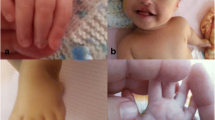Summary
Cytogenetic and molecular analyses of three dicentric X chromosomes were performed in an attempt to identify the parental origin and mechanism of formation of the aberant chromosomes. Results indicate that, in these three cases, the dicentric chromosomes were formed by chromatid breakage and reunion of sister chromatids at the breakpoint. In two cases the abnormal chromosomes were paternal in origin; in the third case the dicentric originated from the maternal X chromosome.
Similar content being viewed by others
References
Bell GT, Karam JH, Rutter WI (1981) Polymorphic DNA region adjacent to the 5′ end of the human insulin gene. Proc Natl Acad Sci USA 78:5759–5763
Callen DF, Mulley JC, Baker EG, Sutherland GR (1987) Determining the origin of human X isochromosomes by use of DNA sequence polymorphisms and detection of an apparent i(Xq) with Xp sequences. Hum Genet 77:236–240
Cavenee W, Leach R, Mohandas T, Pearson P, White R (1984) Isolation and regional localization of DNA segments revealing polymorphic loci from human chromosome 13. Am J Hum Genet 36:10–12
Dewald GW, Spurbeck JL, Gordon H (1978) Replication patterns of three isodicentric X chromosomes and an X isochromosome in human lymphocytes. Am J Med Genet 1:445–460
Gilliam TC, Scambler P, Robbins T, Ingle C, Williamson R, Davies KE (1984) The positions of three restriction fragment length polymorphisms on chromosome 4 relative to known genetic markers. Hum Genet 68:154–158
Knowlton R, Nelson C, Brown V, Page D, Donis-Keller H (1986) A highly polymorphic locus on the X chromosome has homology on the Y chromosome. Am J Hum Genet 39: A160
Oberle I, Drayna D, Camerino G, White R, Mandel J-L (1985) The telomeric region of the human X chromosome long arm: presence of a highly polymorphic marker and analysis of recombination frequency. Proc Natl Acad Sci USA 81:2836–2837
Page DC, Bieker K, Brown LG, Hinton S, Leppert M, Lalouel J-M, Lathrop M, Nystrom-Lahti M, Chapelle A de la, White R (1987) Linkage, physical mapping, and DNA sequence analysis of pseudoautosomal loci on the human X and Y chromosomes. Genomics 1:243–256
Pai GS, Thomas GH (1980) A new R-banding technique in clinical cytogenetics. Hum Genet 54:41–45
Patterson M, Schwartz C, Bell M, Sauer S, Hofker M, Trask B, Engh G van der, Davies KE (1988) Physical mapping studies on the human X chromosome in the region of Xq26-Xqter. Genomics 1:297–306
Schwartz CE, McNally E, Leinwand L, Skolnick MH (1986) Linkage of a myosin heavy chain locus to an anonymous single copy locus (D1751) at 17p13. Cytogenet Cell Genet 43:117–120
Schwartz CE, Fitch N, Phelan MC, Richer C-L, Stevenson RE (1987) Two sisters with a distal deletion at the Xq26/Xq27 interface: DNA studies indicate that the gene locus for factor IX is present. Hum Genet 76:54–57
Weabright M (1971) A rapid banding technique for human chromosomes. Lancet II: 971–972
Stevenson RE, Phelan MC, Schwartz CE, Simensen RJ (1987) Duplicated X chromosome in a child with features of Turner syndrome. Proc Greenwood Genet Center 6:27–31
Sumner AT (1972) A simple technique for demonstrating centromeric heterochromatin. Exp Cell Res 75:304–306
Therman E, Sarto GE, Patau K (1974) Apparently isodicentric but functionally monocentric X chromosome in man. Am J Hum Genet 26:83–92
Therman E, Trunca C, Kuhn EM, Sarto GE (1986) Dicentric chromosomes and the inactivation of the centromere. Hum Genet 72:191–195
Ward BE, Bradley CM, Cooper JB, Robinson A (1981) Homodicentric chromosomes: a distinctive type of dicentric chromosome. J Med Genet 18:54–58
Wyman AR, White RL (1980) A highly polymorphic locus in human DNA. Proc Natl Acad Sci USA 77:6754–6758
Yunis JJ (1976) High resolution of human chromosomes. Science 191: 1268–1270
Author information
Authors and Affiliations
Rights and permissions
About this article
Cite this article
Phelan, M.C., Prouty, L.A., Stevenson, R.E. et al. The parental origin and mechanism of formation of three dicentric X chromosomes. Hum Genet 80, 81–84 (1988). https://doi.org/10.1007/BF00451462
Received:
Revised:
Issue Date:
DOI: https://doi.org/10.1007/BF00451462




